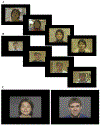Learning context and the other-race effect: Strategies for improving face recognition
- PMID: 29604301
- PMCID: PMC8805210
- DOI: 10.1016/j.visres.2018.03.003
Learning context and the other-race effect: Strategies for improving face recognition
Abstract
People recognize faces of their own race more accurately than faces of other races-a phenomenon known as the "Other-Race Effect" (ORE). Previous studies show that training with multiple variable images improves face recognition. Building on multi-image training, we take a novel approach to improving own- and other-race face recognition by testing the role of learning context on accuracy. Learning context was either contiguous, with multiple images of each identity seen in sequence, or distributed, with multiple images of an identity randomly interspersed among different identities. In two experiments, East Asian and Caucasian participants learned own- and other-races faces either in a contiguous or distributed order. In Experiment 1, people learned each identity from four highly variable face images. In Experiment 2, identities were learned from one image, repeated four times. In both experiments we found a robust other-race effect. The effect of learning context, however, differed depending on the variability of the learned images. The distributed presentation yielded better recognition when people learned from single repeated images (Exp. 1), but not when they learned from multiple variable images (Exp. 2). Overall, performance was better with multiple-image training than repeated single image training. We conclude that multiple-image training and distributed learning can both improve recognition accuracy, but via distinct processes. The former broadens perceptual tolerance for image variation from a face, when there are diverse images available to learn. The latter effectively strengthens the representation of differences among similar faces, when there is only a single learning image.
Keywords: Face recognition; Learning context; Other-race effect; Training.
Copyright © 2018 Elsevier Ltd. All rights reserved.
Figures








Similar articles
-
Face Recognition by Humans and Machines: Three Fundamental Advances from Deep Learning.Annu Rev Vis Sci. 2021 Sep 15;7:543-570. doi: 10.1146/annurev-vision-093019-111701. Epub 2021 Aug 4. Annu Rev Vis Sci. 2021. PMID: 34348035 Free PMC article. Review.
-
Learning own- and other-race facial identities from natural variability.Q J Exp Psychol (Hove). 2019 Dec;72(12):2788-2800. doi: 10.1177/1747021819859840. Epub 2019 Jul 9. Q J Exp Psychol (Hove). 2019. PMID: 31184257
-
Neural correlates of memory encoding and recognition for own-race and other-race faces in an associative-memory task.Brain Res. 2017 Jan 15;1655:194-203. doi: 10.1016/j.brainres.2016.10.028. Epub 2016 Nov 2. Brain Res. 2017. PMID: 27815095
-
Two faces of the other-race effect: recognition and categorisation of Caucasian and Chinese faces.Perception. 2009;38(8):1199-210. doi: 10.1068/p6136. Perception. 2009. PMID: 19817152
-
Bilingualism shapes the other race effect.Vision Res. 2019 Apr;157:192-201. doi: 10.1016/j.visres.2018.07.004. Epub 2018 Sep 8. Vision Res. 2019. PMID: 30102922
Cited by
-
Seeing through disguise: Getting to know you with a deep convolutional neural network.Cognition. 2021 Jun;211:104611. doi: 10.1016/j.cognition.2021.104611. Epub 2021 Feb 13. Cognition. 2021. PMID: 33592392 Free PMC article.
-
What happens to our representation of identity as familiar faces age? Evidence from priming and identity aftereffects.Br J Psychol. 2022 Aug;113(3):677-695. doi: 10.1111/bjop.12560. Epub 2022 Mar 11. Br J Psychol. 2022. PMID: 35277854 Free PMC article.
-
The effect of face masks and sunglasses on identity and expression recognition with super-recognizers and typical observers.R Soc Open Sci. 2021 Mar 24;8(3):201169. doi: 10.1098/rsos.201169. R Soc Open Sci. 2021. PMID: 33959312 Free PMC article.
-
Face Recognition by Humans and Machines: Three Fundamental Advances from Deep Learning.Annu Rev Vis Sci. 2021 Sep 15;7:543-570. doi: 10.1146/annurev-vision-093019-111701. Epub 2021 Aug 4. Annu Rev Vis Sci. 2021. PMID: 34348035 Free PMC article. Review.
-
Collaboration to improve cross-race face identification: Wisdom of the multi-racial crowd?Br J Psychol. 2023 Nov;114(4):838-853. doi: 10.1111/bjop.12657. Epub 2023 Apr 24. Br J Psychol. 2023. PMID: 37093063 Free PMC article.
References
-
- Crowder RG (1976). Principles of learning and memory. New York: John Wiley & Sons.
Publication types
MeSH terms
Grants and funding
LinkOut - more resources
Full Text Sources
Other Literature Sources

